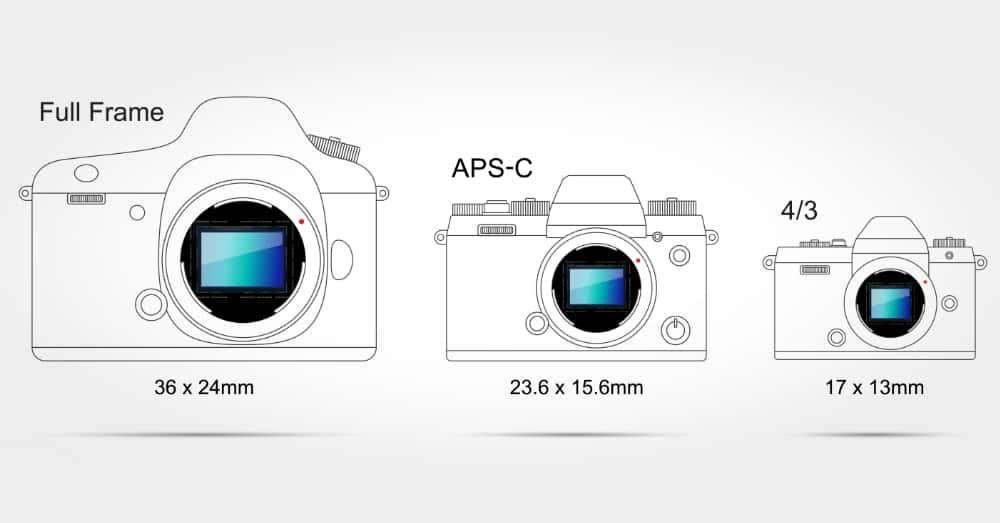Exploring Sensor Sizes in Beginner Photography: APS-C vs. Full Frame vs. Micro 4/3

If you're new to photography, the array of sensor sizes available may leave you bewildered. Why so many options, and what sets them apart? How does the sensor size affect image quality, and which one should you opt for?
These are all common questions, and in this article, we aim to clarify the distinctions between Full Frame, APS-C, and Micro Four Thirds sensors in a straightforward manner, avoiding overly technical details.
Overview of Sensor Sizes: Full Frame, APS-C, Micro 4/3, and ABeyond
Sensor Size: The photography world has seen a proliferation of sensor formats, offering diverse choices for photographers. A simple rule of thumb prevails here: when considering different sensor sizes, remember that bigger is usually better.
Small Sensors (Up To 1”-Type): Sensor sizes smaller than 1” are typically found in camera phones and entry-level compact cameras. Prosumer compact and bridge cameras, like the Sony RX100 and RX10 series, often use a 1”-type sensor or larger, ensuring improved image quality, better low-light performance, and reduced digital noise compared to smaller sensors.
Medium Size Sensors: Four Thirds and Micro Four Thirds Formats: While Canon and Nikon opted for larger sensors for their DSLR cameras, Olympus adopted the Four Thirds (FT) format, slightly larger than 1”-type sensors. In collaboration with Panasonic, Olympus introduced the Micro Four Thirds (MFT) standard for their mirrorless cameras, with the same sensor size as Four Thirds. However, with Panasonic shifting toward full-frame mirrorless cameras, Olympus may continue to champion the MFT standard.
Large Sensors: APS-C and Full Frame Formats: DSLR cameras, traditionally geared toward professionals, have consistently employed some of the largest sensors, namely APS-C and Full Frame (FF) formats. These were the market's largest sensors until the emergence of digital medium format, which remains cost-prohibitive for many.
How Small is... Small? The Crop Factor: The Full Frame sensor serves as the reference point, measuring 36 x 24 mm. All other digital sensors on the market are smaller. You can compare sensor dimensions using the Crop Factor (CF), defined as the ratio of a 35mm frame's diagonal to the sensor's diagonal. For instance, MFT has a CF of 2.
In the same way we can calculate the CF for the most common sensor types:
- Full Frame: CF = 1
- Canon APS-C: CF = 1.6
- Nikon, Pentax, Sony and Sigma APS-C: CF = 1.5
- Panasonic and Olympus MFT: CF = 2
- 1″-type: CF = 2.72
- 1/3″: CF = 7.7
Sensor Size and Real-Life Photography: What Changes?
Costs: Larger sensors offer superior performance but come at a higher price. If you opt for a FF camera, be prepared to invest more.
Field of View: Smaller sensors result in a narrower field of view, with the extent of change determined by the crop factor, affecting the angle of view.
Depth of Field: Smaller sensors lead to a larger depth of field, which can be crucial for portraiture and creating separation between the subject and the background.
Sensor Resolution and Optical Resolution: Sensor resolution, expressed in megapixels, varies with sensor size. Smaller sensors tend to have smaller pixels, resulting in higher optical resolution and the ability to capture finer details.
Quality of Image in Low Light: Larger sensors, especially FF sensors, offer better low-light performance, reduced noise, and a larger dynamic range, making them suitable for various photography scenarios.
Lenses: Lenses must match the sensor size to provide a circular image. Full-frame lenses are larger because they need to cover a larger area. Mirrorless cameras have evolved, and many now use full-frame sensors, requiring similar lenses to their DSLR counterparts.
Does Sensor Size Matter in Astrophotography?
Do I Need a Full-Frame Camera for Astrophotography? Full-frame cameras excel in astrophotography due to their low-light capabilities and large pixels that efficiently capture light.
Should I Upgrade from MFT and APS-C to Full-Frame? Upgrading to a full-frame camera for astrophotography may not always justify the expense. Smaller sensors have improved over time and can perform admirably. Consider sensor size, your budget, and specific astrophotography needs.
Is There a Place for Small Sensor Cameras in Astrophotography? Planetary astrophotography often benefits from small sensors with high resolution, which allows for excellent optical resolution when used with long-focal-length telescopes.
In Conclusion: Sensor size indeed matters, with full-frame cameras excelling in low-light performance and overall image quality. However, the best choice depends on your specific needs, with compromises to consider, such as the bulkiness of full-frame cameras and their impact on star trackers. Tailor your equipment to match your photography goals.
